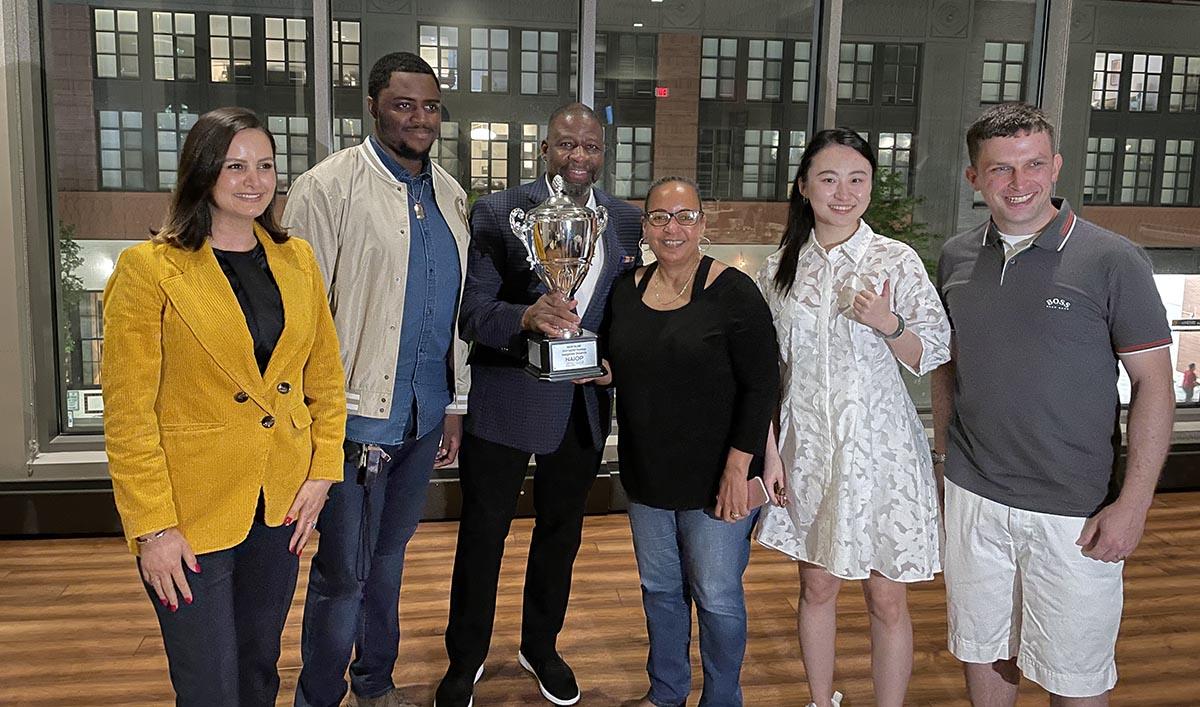A team of four graduate students from the University of Maryland’s Colvin Institute of Real Estate Development has won first place in the NAIOP DC l MD 2021 Capital Challenge, an intercollegiate real estate competition for the Washington, D.C. area. UMD’s development strategy for a high-profile property in Fairfax County prevailed over proposals from Georgetown University, American University and George Mason University in a nail-biter live presentation on April 23rd.
“After watching the team’s mock presentation, I knew that they had a winning proposal,” said Maria Day-Marshall, Director, Colvin Institute of Real Estate Development. “The students were poised and well-prepared to compete in the competition. It was evident that they had worked hard, and I could not be prouder of their efforts. Ron McDonald was a great advisor for these students and used his vast experience in this competition to lead them to the winners circle.”
Team UMD is: Weishi Zhang, John Plachta, Sharmin Davoodian and William Christian. Ron McDonald served as faculty advisor.
The Capital Challenge is a case study competition where teams from area collegiate real estate programs go head-to-head to develop and present proposals for a real property in the Washington, D.C. / Maryland / Virginia area. Teams must formulate a proposed investment strategy and develop a comprehensive analysis with recommendations that will maximize the potential of the property, while showing that it is both feasible and financially advantageous. Now in its twelfth year, the Capital Challenge is hosted annually by NAIOP, the Commercial Real Estate Development Association that is the leading organization for developers, owners and related professionals in office, industrial, retail and mixed-use real estate.
This year’s site challenged teams to devise the third phase of development for the Boro, a walkable, mixed use downtown district in Tyson’s Corner, Virginia, developed by the Meridian Group. A deep-dive market analysis, design process and feasibility study by the UMD team resulted in the Duet, a dynamic development project that offers a mix of retail, residential, greenspace and a hotel property, and underscores the Boro’s vibrant live-work-play environment. Amenities, like a rooftop restaurant and greenspace, a food hall and boutique recreation options, capture the current market demand in the rapidly-growing pocket of Fairfax County, particularly among young professionals.
The UMD Team played to Meridian’s focus on wellness to home in on 1 Hotels, a sought after, sustainably-focused luxury hotel property that currently does not have a foothold in the Washington, D.C. area. To strengthen their case, team members took the added step to meet with the 1 Hotels development team. The extensive legwork put in by Team Maryland, McDonald says, gave them a significant edge in front of the competition judges.
“They did a really deep dive because, when they get before the judges, the questions are very specific,” said McDonald. “The fact that they had conversations with the hotel development team and could speak knowledgably about the feasibility gave them the ammunition to really defend their proposal. When we won in 2017, I think the judges bristled at what the students put together because it was unconventional, but they made such a powerful case they won the competition.”
Just as important as the amenities are the financials: the team outlined two potential pathways for the project, one with concurrent development and a shorter timeline and one broken into two phases that tacked on an extra year, demonstrating that the second scenario not only offered a higher return, it provided more flexibility to reflect a post-pandemic market.
McDonald says the team’s size—a lean four students—also gave them an edge, as did the multidisciplinary nature of the program, housed within the School of Architecture, Planning and Preservation.
“It’s something I’ve heard the judges remark about before,” he said. “The multidisciplinary nature of our program allows us to take four students and pretty much accomplish what other teams do with 10.”
It also allows equal face time with the judges; McDonald, who has mentored multiple teams for Maryland for this and other competitions, ensures that each student is able to touch all aspects of the project, are well-versed in the financials and get equal time to present and answer questions.
“It makes for a much more impressive effort and, when the competition is close like it was this year, that can make the difference,” he says.
In addition to McDonald, the students benefited from a contingent of NAIOP professional advisors, including alumni, providing a set of best practices and learned strategies. The team’s 2021 partners were JBG Smith, DPR Construction, Hickok Cole, ECS and PNC Real Estate.
This is the second time Maryland has claimed victory in the NAIOP Capital Challenge. In 2017, Danny Green, Tom Parker, Oluwatobi (Tobi) Thomas, Oluwatomi (Tomi) Thomas and McDonald brought home the gold with a mixed-use development in Clarksburg, Maryland.
In addition to a first-place trophy, UMD also walked away with a $10,000 cash scholarship prize.
“It’s so rewarding to work with such bright students,” says McDonald, who relishes coming back to mentor at Maryland year after year. “In the end, they understood how the project came together and why they did what they did. You get these hard-working students and they can amaze you.”


